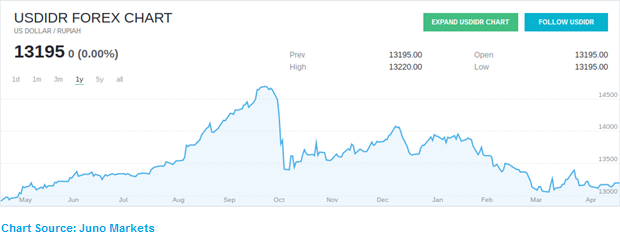Can the Indonesian Rupiah Continue to Rally?
Over the last few months, we have seen some impressive gains in the Indonesian rupiah (IDR) relative to the US dollar (USD). When we compare the performance of the IDR against the rest of the emerging market space, we can see that its gains are behind only the Brazilian real (BRL) and the Malaysian ringgit (MYR) for the period. This has prompted a wave of foreign export purchases as Indonesian consumers look to take advantage of the stronger currency.
So the next question to ask is whether or not these trends are likely to continue. Most of the bullish movement has been based on moderating inflationary pressures and recoveries in commodities prices. This helps to brighten the outlook for the potential GDP growth numbers we are likely to see toward the end of this year. It could also be a set of factors that helps the IDR to see further increases before the end of the year.
Chart View: US Dollar vs. Indonesian Rupiah
In the chart above, we can see that relative to the US dollar the IDR is trading back toward where it was trading last April. The market has erased the gains that were made toward the end of last year, but the lack of progress made at these long term lows suggests that investors have found a value base and that prices are unlikely to continue declining. On the whole, this is a positive scenario that ultimately suggests the IDR will be trading higher at the end of this year than it is today.
Fed Factor
Potential situations that could reverse this outlook would be seen if the US Federal Reserve signalled intentions to aggressively raise interest rates. This is a peripheral factor that could weigh on the IDR as it would suggest reduced spending in emerging market economies. This is something that would be viewed negatively by market analysts, but if this does not occur then we would still find ourselves in a scenario that supports the bullish case for the rupiah.
In any case, these are all factors that will continue to be on the radar for those looking to invest in emerging markets and for Indonesia, in particular. We are not only looking at internal and domestic factors at this stage, and there is still some level of uncertainty with respect to how these influences will change the value of the currency by the end of this year.

